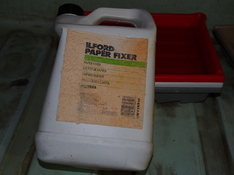Melvin J Bramley
Member
I have acquired a unopened 4ltr container of Ilford PAPER developer fixer not Rapidfix!
Does anyone have any idea why they would produce a fixer just for paper?
I will try it and use hypo check to verify its condition plus the twice clearing time, for film, which is usually about 1 minute.
My question is curiosity driven not technical.
FWIW
In the same acquisition of older chemicals and paper I had 500 ml of , at least 4 year old , Ilford Ilfosol 3 which worked wonderfully.
I am finding Ilford liquid concentrates performing well way after their best by dates.
Does anyone have any idea why they would produce a fixer just for paper?
I will try it and use hypo check to verify its condition plus the twice clearing time, for film, which is usually about 1 minute.
My question is curiosity driven not technical.
FWIW
In the same acquisition of older chemicals and paper I had 500 ml of , at least 4 year old , Ilford Ilfosol 3 which worked wonderfully.
I am finding Ilford liquid concentrates performing well way after their best by dates.
Last edited by a moderator:












